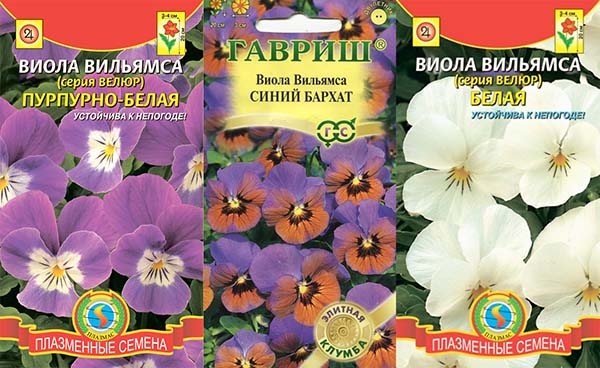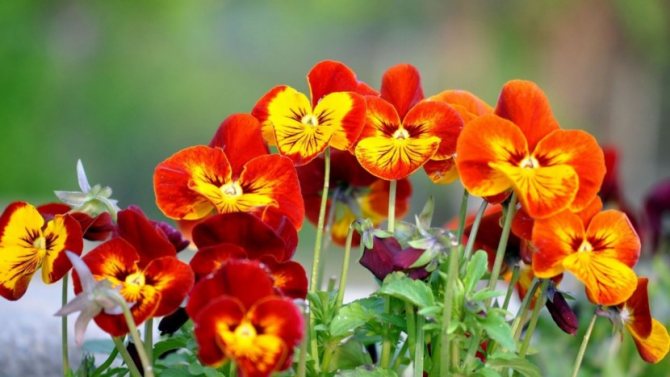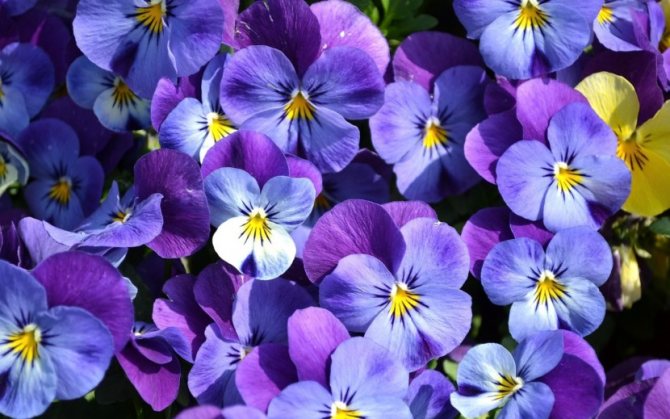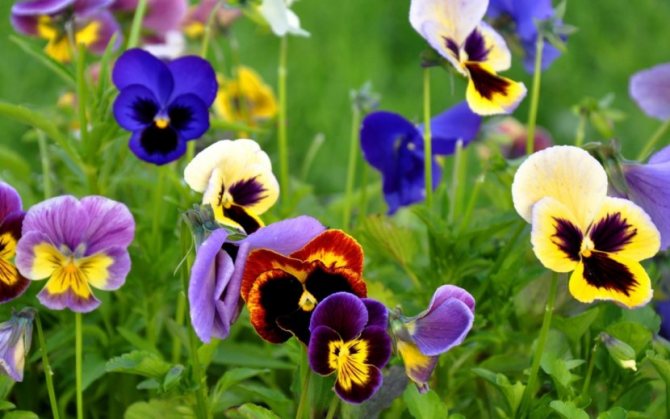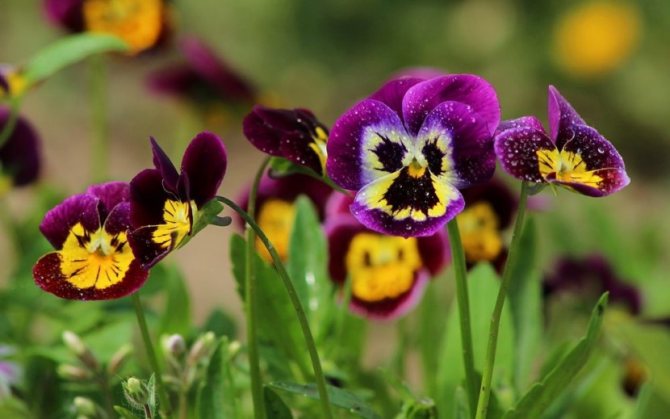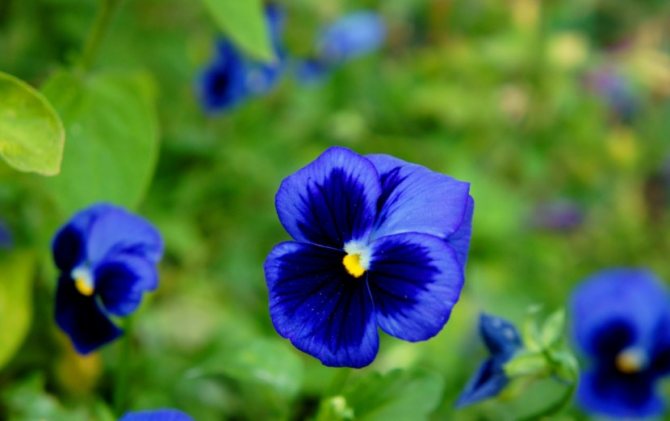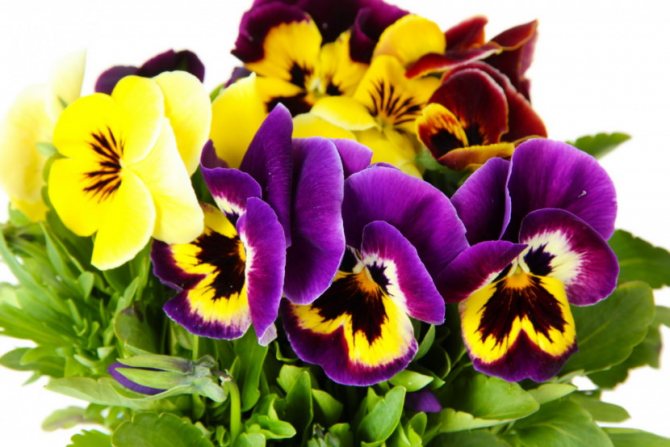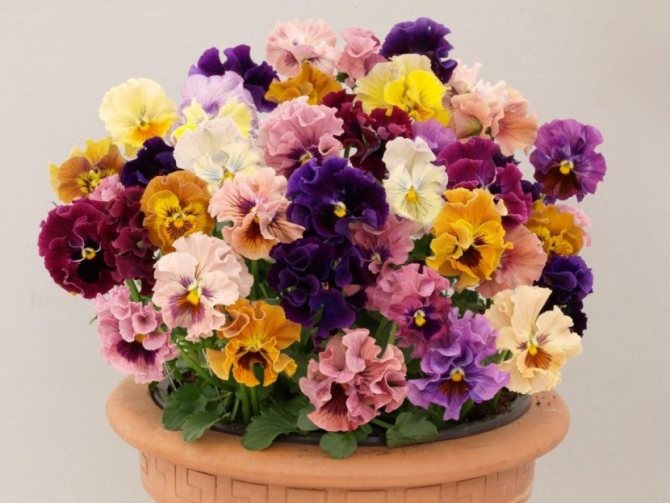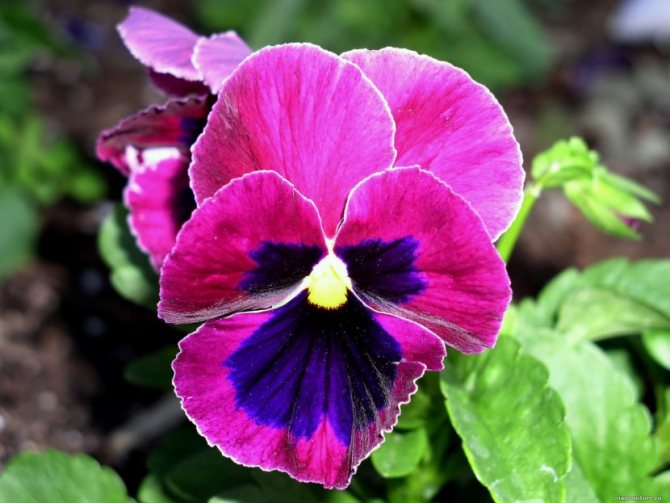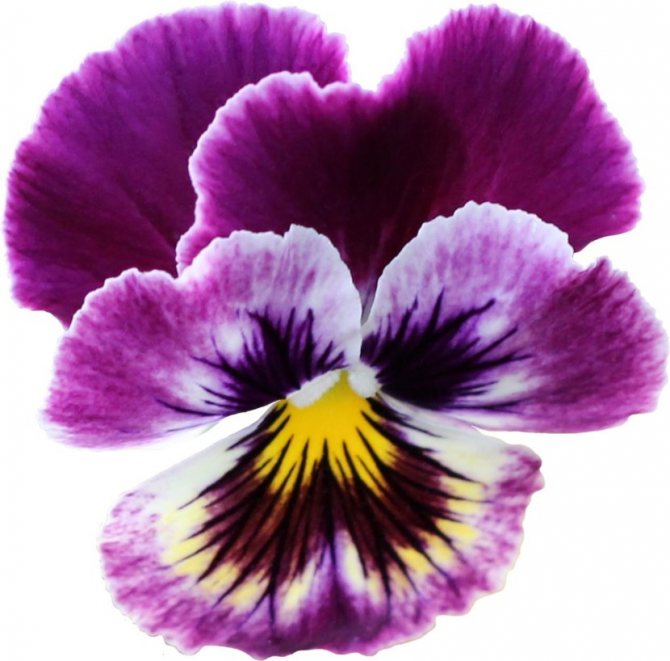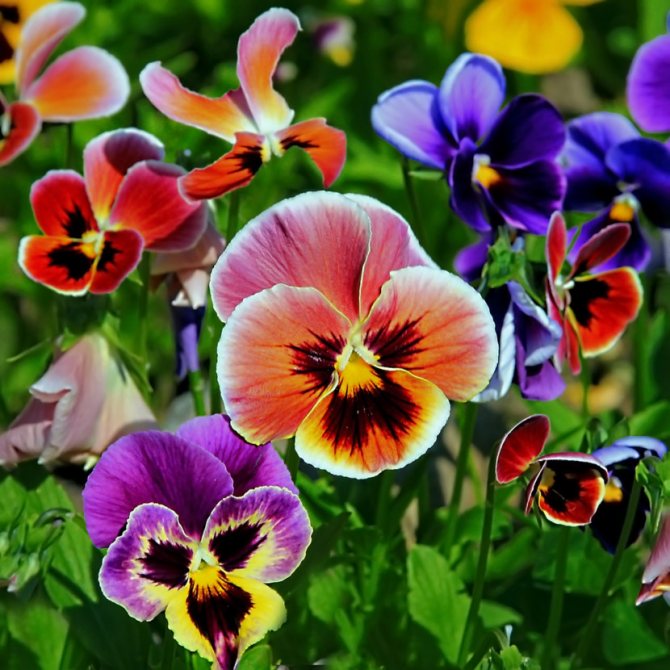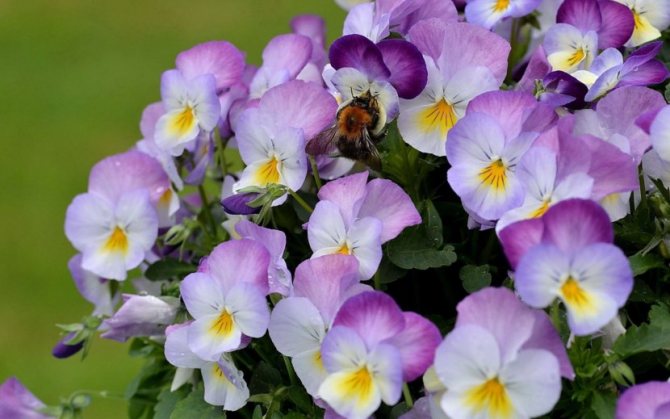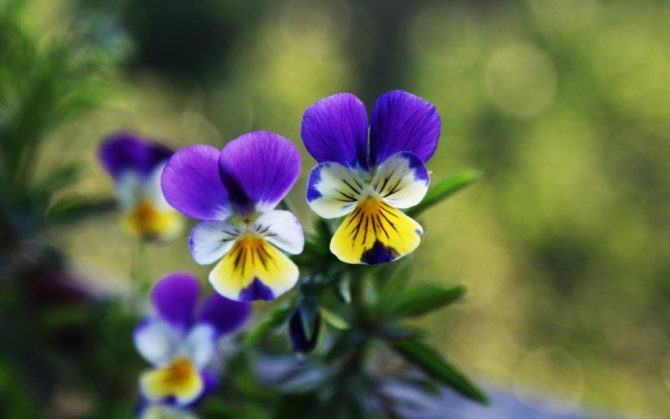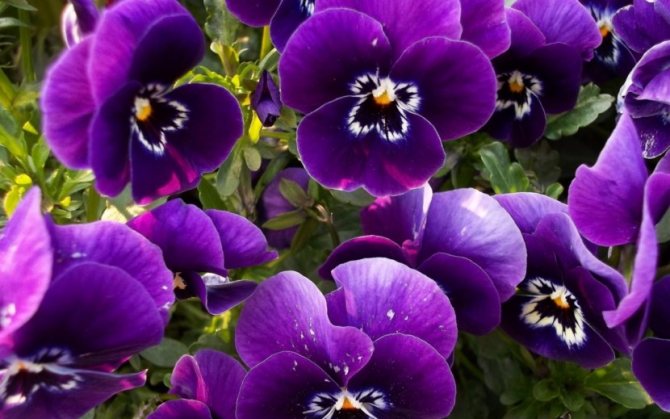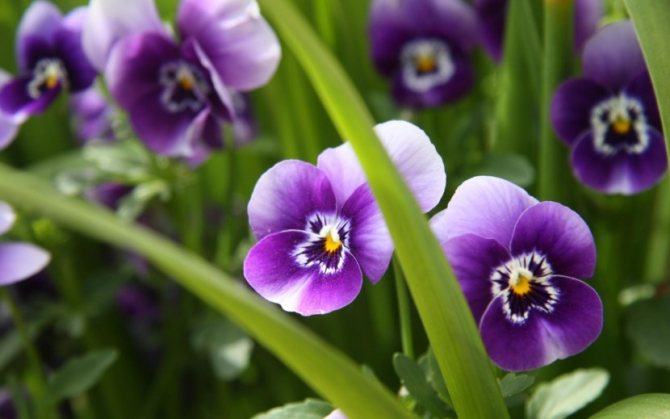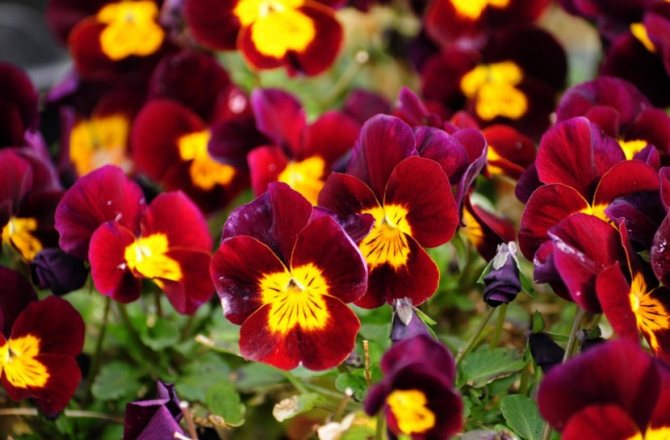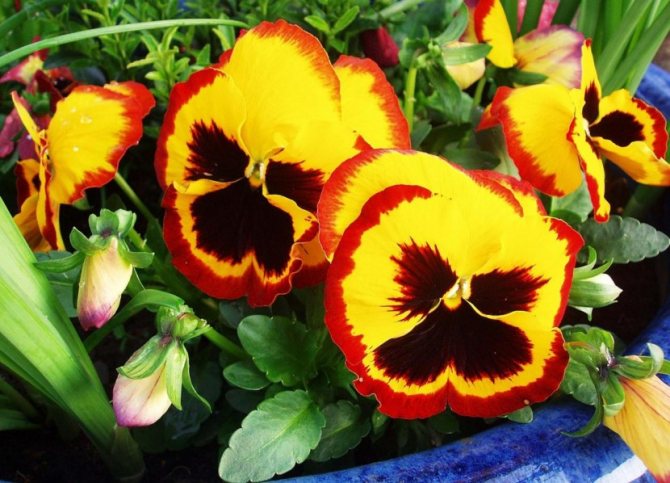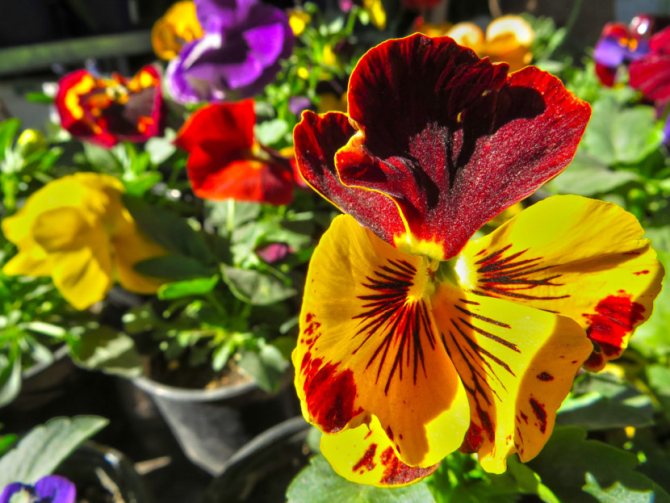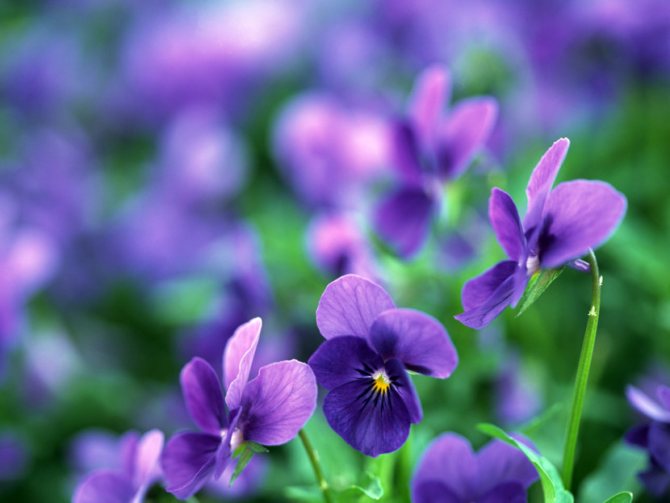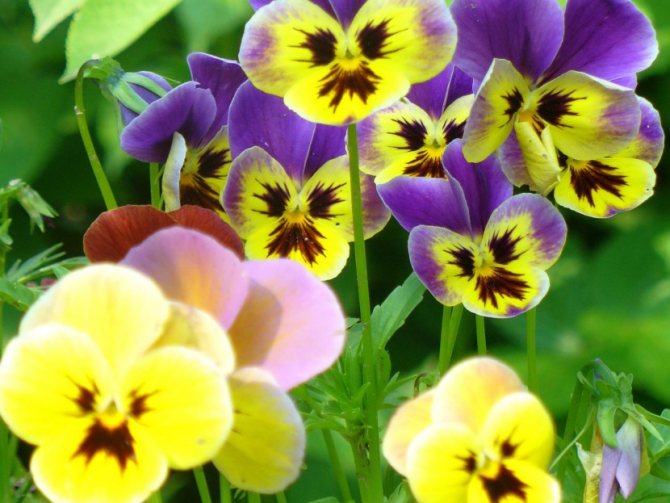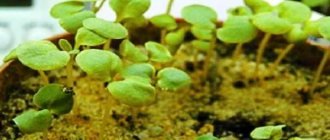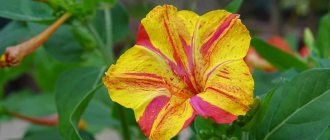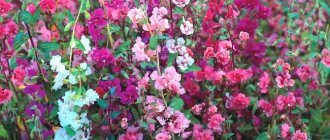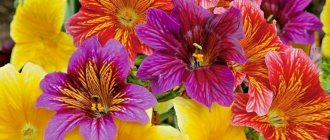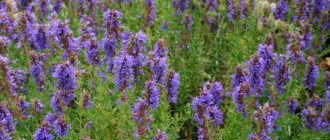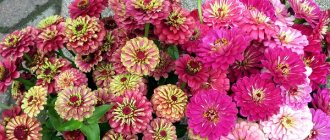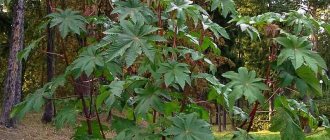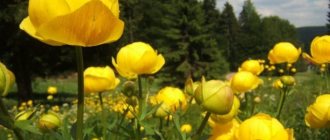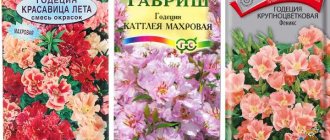Content
- Why Pansies were called that
- Pansies varieties photos and names
- Pansies growing from seeds
- Viola primer
- Pansy landing
- Watering the viola
- Fertilizer for tricolor violets
- Pansy trimming
- Pansy flowering period
- Tricolor violet in winter
- Pansies growing from seeds when to plant
- Pansies propagation by cuttings
- Reproduction of a tricolor violet by dividing a bush
- Diseases and pests
- Pansies medicinal properties
Seedling care
Taking care of pansies in the early months can seem like a chore. Seedlings require a certain light, temperature and water regime. In fact, in order to end up with healthy seedlings, you need to adhere to a few simple rules.
Lighting and temperature control
If the seeds are planted in February - March, it is enough to put the seedlings on the southern windows. If you are planting pansies before winter, prepare your lighting equipment in advance. Sprouts are demanding on the level of illumination, their viability directly depends on this.
It is better if the containers are located on the southern windowsills in order to get the most of natural light. Additionally, several fluorescent or LED lamps are placed 15 cm above them. The luminous flux power in total must be at least 5000 lm.
The backlight should never be left overnight! Enough 13-14 hours. Plants need rest.
The optimum temperature for the emergence of seedlings is 20-22 degrees. Then it is reduced to 16-18 ° C, otherwise the seedlings will begin to stretch and fall. Young growth is very sensitive to cold drafts.
Watering and fertilizing
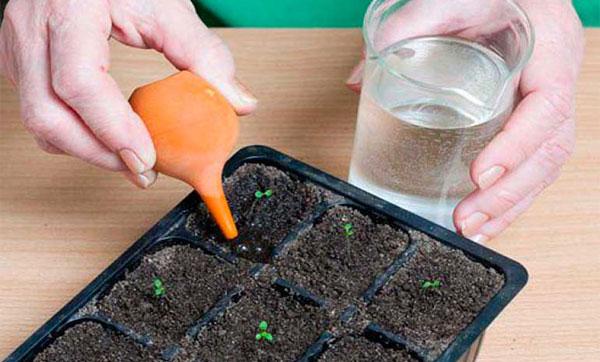
several weeks of planting are watered with a syringe or sprayed with a spray bottle, trying to direct a stream of water into the aisles. Water is used standing and slightly warmed up. After the appearance of the cotyledon leaves, the seedlings are sprayed once with a solution of Epin or Zircon.
After the seedlings "leave" the greenhouses, it is important to keep the soil in a moderately moist state at all times. If the top layer dries up, the delicate roots will die; excess moisture leads to the intensive development of fungal diseases. They begin to feed pansies 2 weeks after picking with fertilizer for seedlings with a high content of phosphorus and potassium.
When to dive
Pansies dive after the appearance of 2-3 pairs of true leaves. At the same time, they start with the largest seedlings, giving the rest the opportunity to grow up. They are removed from the soil with a needle or tweezers, taking care not to damage the fragile stems.
They are seated in disposable cups or pots with a volume of 0.25 liters. Drainage holes are necessarily made in them, and a layer of expanded clay is laid on the bottom. The soil should be more dense than for sowing seeds: 10 parts of leafy soil, 3 parts of peat, 2 parts of sand.
The soil is watered, a hole is made in it, a seedling is placed in it and covered. Then water it again abundantly, holding the plant until the earth settles. You don't need to put pansies in the greenhouse after picking pansies. The requirement for the level of illumination of the seedlings after picking increases. After 2-3 weeks, the seedlings are pinched to prevent them from stretching and to form more lush bushes.Seeds, planted 1-2 pieces in peat tablets, do not dive.
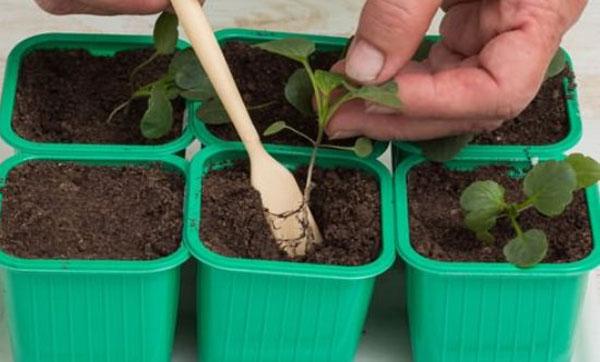

Seedling diseases and pests
It is not enough to sow seedlings of pansies, they need to be saved until the moment they are planted in open ground. Here the gardeners are waiting for how difficult it is. The main one is fungal diseases, which young plants are susceptible to in conditions of insufficient sunlight.
Disease control can be helped by:
- Sand on the surface of the soil and in its composition. The fungus is always present in the substrate and air. But he can "attack" the seedlings only through the drops of water that collect at the stems after watering. The sand quickly draws in moisture, preventing it from accumulating and forming infectious droplets.
- Potassium permanganate: seedlings are watered with a pink solution once a week to reduce the number of spores in the soil.
- Quartzization. Ultraviolet light destroys fungal spores. In winter, when there is little sun, it can be "replaced" with daily half-hour treatments.
- Processing by Epin or Zircon "on the sheet". These drugs are, in fact, potash fertilizers, and stimulate not only growth, but also immunity. Apply no more than 1 time per month.
Professional growers advise not to fertilize seedlings with fertilizing with a high nitrogen content. Yes, it helps to gain green mass, but at the same time it is a breeding ground for spores.
If you grow pansies on an insulated windowsill, you don't have to worry about pests. Viola can be attacked by some caterpillars and aphids, but eggs will not survive in heat-treated soil. If the seedling of a tricolor violet grows in a greenhouse, a spider mite may "encroach" on it. At the first signs of damage - traces of bites, cobwebs - treat the plants with any acaricide. It is important to respect the dosage indicated by the manufacturer. There should be at least three treatments, with an interval of exactly 7 days.
Why Pansies were called that
The true origin of the flower's name is not known. There are only legends and myths. One of these legends tells that once upon a time there lived a girl named Anyuta. One day she met a young man and fell deeply in love with him. After some time, the young man decided to leave, but he made an oath that he would return to his chosen one.
Anyuta many times went out on the road along which her beloved left. She peered into the distance, hoping to see him. She waited a long time, but the young man never returned. Gradually fading away from loneliness and melancholy, Anyuta died.
After the burial, flowers grew on her grave, resembling eyes that tirelessly looked somewhere into the distance. This is how the popular name of pansies appeared.
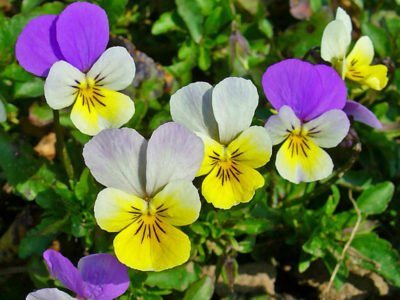

Pansies varieties photos and names
Pansy Weiss - the variety has pure white flowers with wavy edges. The size of the opened bud varies from six to eight centimeters. The total height of the shrub reaches thirty-five centimeters.
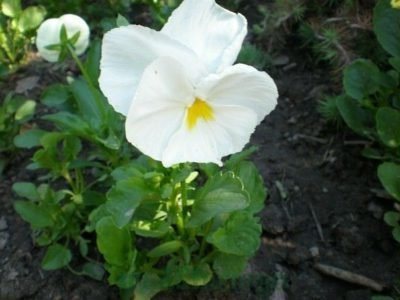

Pansies White - This variety has white flowers with yellow blotches. The size of the opened buds reaches seven centimeters. The length of the pedicel varies from eight to twelve centimeters.
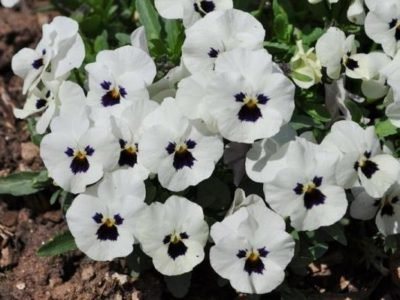

Pansies Blue - the flowers of this variety are colored blue and purple. The petals have straight edges and a smooth surface. The size of the flowers varies from six to seven centimeters in diameter. Shoot length is about eleven centimeters.
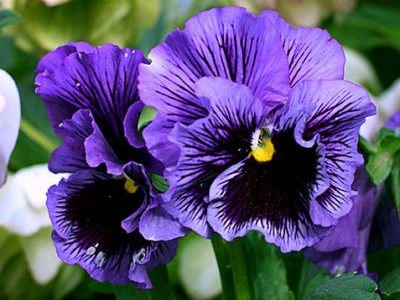

Pansies Abenglut - the flowers of this variety have a cherry and red tint with brown splashes. The petals are smooth with ribbed edges. The size of the flowers is eight centimeters in diameter.
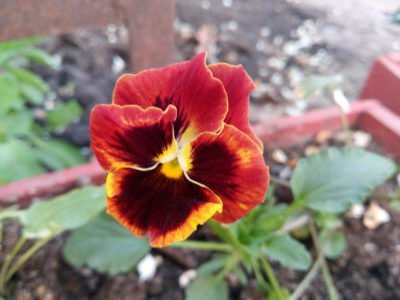

Pansies Golden Yellow - from the name of the variety it is clear that the flowers have a golden hue. The size of the opened buds reaches seven centimeters in diameter. The shoot length does not exceed ten centimeters.
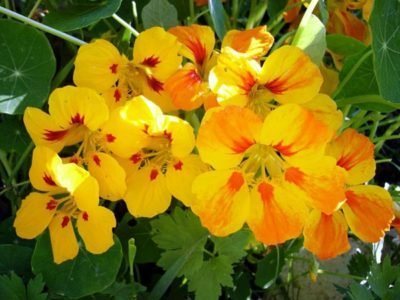

Varieties with large flowers
Pansies Evening Heat - flowers of this variety are brown and red. The lower petals have brown spots. The size of the flowers varies from five to six centimeters.
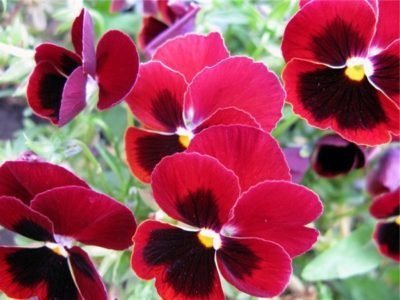

Pansies Himmelskenigin - flowers have a bluish tint. The size of the opened buds is no more than five centimeters in diameter. The total height of the shrub reaches thirty centimeters.
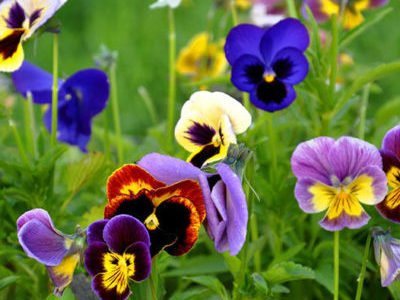

Pansy jupiter - flowers of this variety at the base have a purple and violet tint, and closer to the edges they acquire a white tone. The lower petals are completely white. The size of the opened buds reaches five centimeters. Shoot length is small, about seven centimeters.
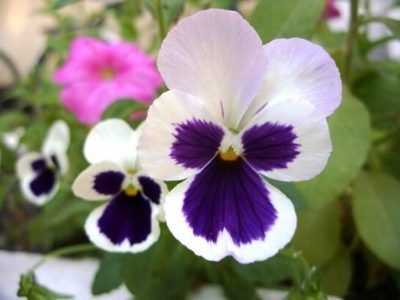

Pansies Winter Sun - flowers are bright yellowish with crimson blotches. All petals have ribbed edges. The stems are nine centimeters long and the flowers are five centimeters in diameter.
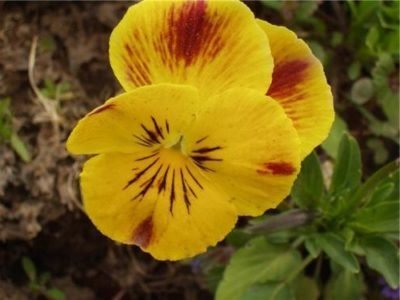

Pansies Magic Martha - This variety has flowers that appear with a dark purple color, but after two days they acquire a black tone. The petals have a velvety surface and smooth edges. The flowers grow up to five centimeters in diameter. The length of the shoots is ten centimeters.
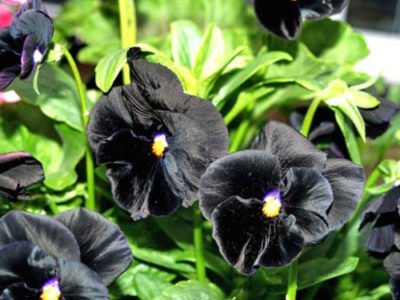

Pansies Heavenly Queen - the flowers of this variety appear with a blue color, but after two days the petals begin to brighten, acquiring a light bluish tint. The size of the flowers reaches five centimeters in diameter. Shoots are about nine centimeters long.
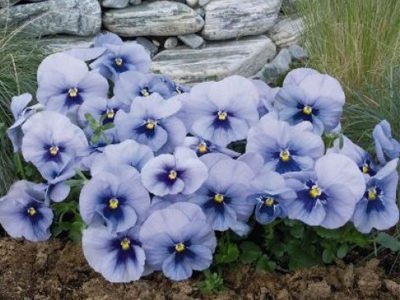

Pansies Ice King - The flowers of this plant are white with long, purple blotches. There are varieties with petals that have white, yellow, purple and green hues. The height of the bush reaches twenty centimeters, and the diameter of the flowers is five centimeters.
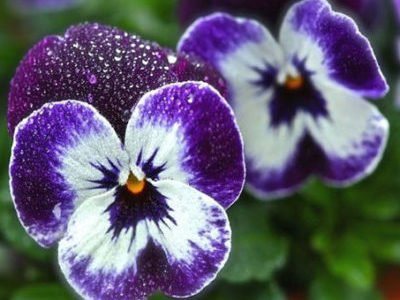

Varieties with small flowers
Pansy Fire King - flowers with a dark red shade with a black base. The lower petals are yellow. The flowers are four centimeters in diameter. The total height of the shrub is twenty centimeters.
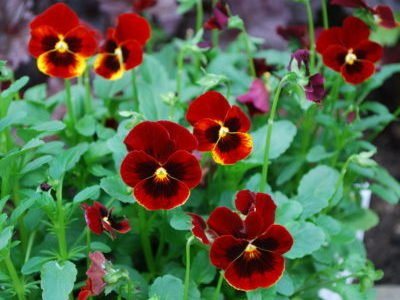

Pansy Little Red Riding Hood - the variety was named after a girl from a folk tale, who had a red cap. Likewise, the flowers of the plant along the edges have a light or dark shade of red, and in the center of the petals there is a black color. The size of the flowers is small, only three centimeters.
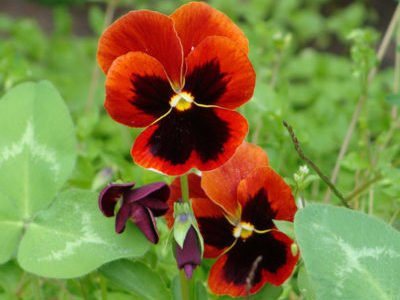

Pansies Snow Maiden - flowers with velvet petals in a pure white tone. The size of the flowers can be up to four centimeters in diameter.
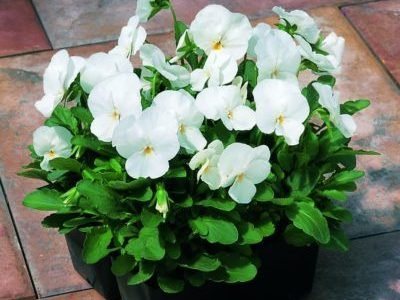

Pansies Blue Boy - this variety has delicate petals with a blue and light blue tint. The flowers grow up to four centimeters in diameter.
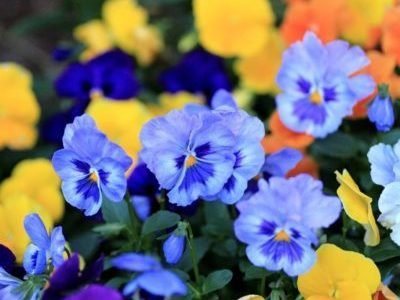

Botanical description
Violas (pansies) are annuals, biennials and perennials of the violet family. China and Japan are considered the birthplace of these flowers. With the onset of spring warmth, they appear on flower beds. Viola opens its petals already at the beginning of spring. There are spring and summer-flowering varieties. Gardeners can choose any variety they like for their garden.
Viols have a thin stem with rounded leaves and single flowers. The height of the stem is from 10 to 30 cm. Inside, the stem is hollow, branched, triangular or erect. The buds of the plant are single with five petals and are located on triangular peduncles with two bracts close to the flower.
Pansy flowers have rather large petals and differ in size. The largest are two out of five, the rest are smaller. By color, they come in very different colors. Their colors range from white to almost black. There are always spots in the center of the bud, which gives the flower a special charm. The flowers can be from 5 to 10 cm in diameter. They rise from the sinuses, exuding a light and delicate aroma. On the stems are oval-shaped leaves of light green color. They have jagged or crenate edges.
Pansies growing from seeds
To please yourself with flowers in the first year, you need to know how to plant this plant correctly. It all starts with sowing seeds at the end of February. To do this, use any plastic boxes filled with slightly acidic soil.
Seeds should be planted to a depth of 5 mm. Then place the drawers in a dark and warm place. In five days, the seedlings will sprout. Having noticed the first shoots, transfer the seedlings to a bright place where the temperature does not exceed + 17 ° C. Watch for moderate soil moisture, feed the seedlings with a soluble fertilizer containing potassium, nitrogen and phosphorus.
When the seedlings germinate well and two leaves appear on each stalk, start planting in cassettes. After completing the transplant, put the boxes in a cool place, where not more than + 13 ° C. During this period, continue to monitor the soil moisture and fertilize.
Violet is a very beautiful flower that can also be grown when nursing at home, the main thing is to follow the rules of care and you will not have any problems with it. All the necessary recommendations can be found in this article.
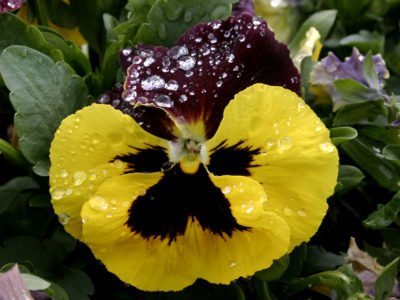

Viola primer
For tricolor violets, you must choose a nutritious soil. In poor soils, such as sandy or clayey, flowers do not grow well, becoming nondescript dwarfs.
To improve bad soil, you need to mix it with fertilizer. Apply 5 kg of plant compost or last year's manure per square meter.
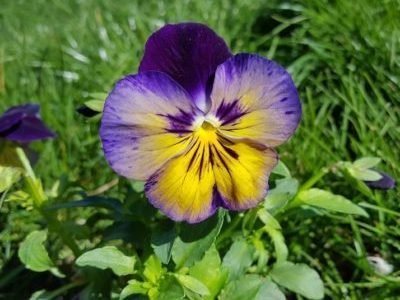

Pansy landing
Violet tricolor is not whimsical when grown outdoors. The only thing she needs is a large space and warmth. Choose an open, sunny area for planting. When you start planting seedlings, observe the distance between the seedlings (15-20 cm). Plants will take root in 3-4 days.
Important! Plant seedlings in open ground two months after diving. The number of leaves of a seedling must be at least 4 pieces.
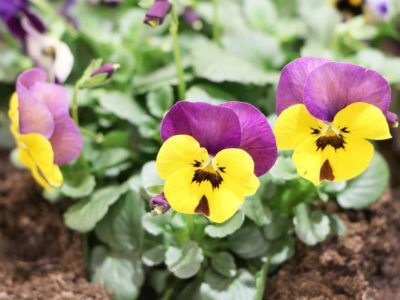

When and how to plant outdoors
The grown pansies are moved at the end of spring. An important point is the absence of late frosts at night.
Before planting tricolor violets, prepare the site and seedlings:
- dig up the soil;
- make holes with an interval between holes from 15 to 20 cm;
- apply organic fertilizers in moderation;
- carefully remove the flower from the pot;
- browsing the root system;
- young plants are placed in prepared pits;
- sprinkle the roots with earth;
- lightly press down the soil around the plant;
- water the soil with warm water with the addition of fungicides;
- the flower can be mulched with sawdust, straw: it is easier to retain moisture, reduce the risk of weeds and parasite attacks.
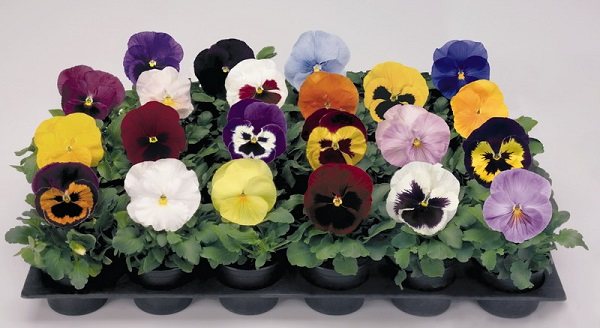

Watering the viola
You need to water the flowers three times a week, and if the weather is hot, then every day. Try not to water the seedlings, but keep the soil moisture at a moderate level. Pour water at the very root.
Important! Do not allow stagnation of water in the ground, this can cause rotting flowers. Loosen the soil after watering.
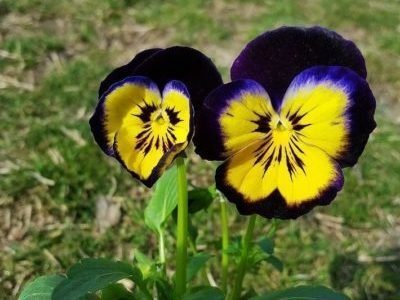

Seedling picking and nipping
The first planting of a young viola is performed when 3-4 leaves appear. Timely surgery accelerates the growth of a beautifully flowering species. This requires:
- take individual pots, larger in volume than the previous ones, always with drainage holes;
- pour soil into flowerpots;
- carefully remove the seedlings without damaging the roots;
- further examine the root system;
- transplanted into prepared cups with a substrate;
- water the flowers with warm, of course, settled water with the addition of organic fertilizers, fungicides;
- containers are placed in a well-lit place, with a lack of light, phytolamp illumination is required;
- room temperature - at the level of + 15 ... + 17 ° С, humidity - 70%;
- watering the substrate as the earthen coma dries;
- the foliage is sprayed with water from a spray bottle.
After the appearance of 8-10 leaves, you can pinch the top growth point of the flower. A simple operation promotes better growth of the green mass. For a beautiful and long-lasting flowering of the pansy bush, faded buds, affected, wilted leaves are removed in time.
Fertilizer for tricolor violets
The first feeding of flowers should be done two weeks after transplanting into open ground. Any complexes of minerals (phosphorus, nitrogen, potassium) are suitable as fertilizers. The next feeding should be done during bud emergence and before flowering.
Important! You cannot fertilize this plant with fresh manure.
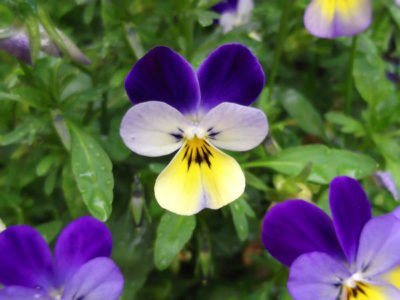

Pansy trimming
Violets multiply rapidly by throwing seeds into the soil. If you do not want the flowers to grow strongly in one place, then you need to remove the seed pods on time. You need to cut flowers at a distance of five centimeters from the ground.
After three weeks, you will have new inflorescences. The same pruning is done if the bushes begin to turn yellow and dry, and the flowers fade and shrink. After two weeks, the shrub will give new shoots.
Important! Leave two leaves on each stem to be cut off.
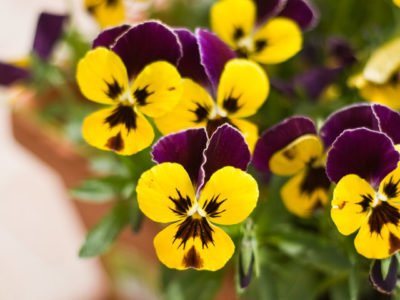

Pansy flowering period
Violets bloom profusely from May until frost, that is, 4-5 months a year. This long flowering is due to the constant change of flowers, which happens imperceptibly.
Old flowers fall off after 3-4 days, and new ones appear in their places. If you want flowers to begin to appear in early spring, then sow seeds outdoors in the second half of summer.
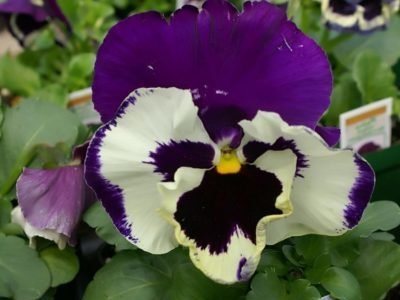

Sowing seeds
Pansies are thermophilic plants. They grow well only in sunny areas. The soil is preferable loose, moist and nutritious. It is best if it is drained with a medium acidity level.
Interesting!
In sunny areas, pansy flowers always grow with large and bright flowers, but the flowering itself does not last long. But in dark places, the opposite is true.
Planting is carried out at different times of the year - it depends on the climate and the desired flowering period. In view of this, there are two methods of growing crops: seeds and seedlings. To begin with, it is worth describing the most popular method - by seeds.
In this case, viols are sown in prepared soil from about the end of July. The land should combine equal amounts of peat, humus, garden soil and sand. Seedlings appear in about 2 weeks. And at the end of summer, the resulting seedlings are transplanted to a permanent place with a distance between individual shoots of 10-30 cm.
Pansies growing from seeds when to plant
This is the main breeding method for violets. The seeds can be purchased at a flower shop or harvested from bushes that have faded. They are planted in seedling boxes or directly into open ground.
The timing of sowing seeds for seedlings may be different. To get early flowering specimens, you can sow in January and February. But for this you will have to provide the seedlings with additional lighting. The first flower buds will appear in late spring and early summer.
Sowing seeds in open ground is carried out in early summer and autumn. In the first case, the plants will show abundant flowering in August and September. And in the second case, sowing will ensure flowering in early spring next year.
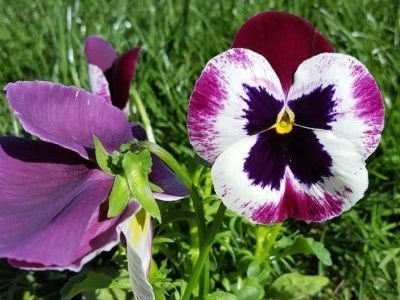

How to sow pansies: soil and seed preparation
It is advisable to place the viola in a special substrate for violets. In stores, you can buy quality soil from well-known manufacturers. When choosing a soil, pay attention to:
- shelf life of the potting mix;
- availability of a quality certificate;
- compliance with the chemical and acid composition requirements for a particular type.
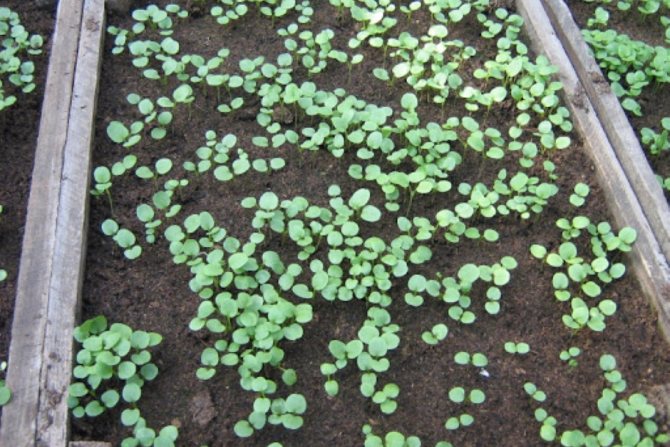

Pansy seeds are often sown in convenient containers with natural material - peat pots or tablets.If it is not possible to buy a ready-made substrate, then deciduous, sod soil, compost, peat, river sand are mixed in equal quantities.
On a note! The soil mixture prepared by yourself must be disinfected. The substrate for violets is placed in the oven, calcined for 30 minutes at a temperature of +100 ° C.
Planting material purchased in an agricultural store, before sowing into the soil, must be treated with growth stimulants. If the grains were collected on their own, then they are placed in a weak solution of potassium permanganate for 20-30 minutes.
Various types of containers are suitable for sowing seeds:
- cups, pots, boxes;
- peat tablets in pallets;
- trays, cassettes for seedlings.
The main thing is that there are drainage holes in the containers. Transplant seedlings into large flowerpots as they grow.
Pansies propagation by cuttings
This method of reproduction helps to preserve the plant with its characteristics.
For example, large-flowered varieties degenerate over time and begin to produce small flowers. The cuttings method can save and propagate such a rare specimen.
To do this, cut off a small shoot with two leaves from the plant and plant it in a glass with soil. Such a stalk will start up the roots by itself without additional stimulants.
Planted scions, water and place away from light in a shady place. After a month, the cuttings will become full-fledged plants that can be transplanted into open ground.
Important! Use soil from the area where you plan to plant flowers. This will help the plant adapt immediately to the characteristics of your soil.
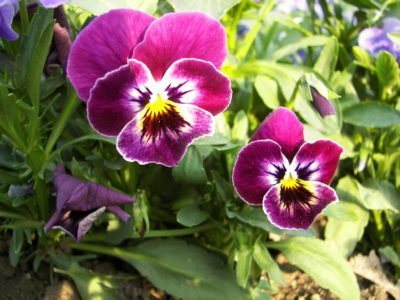

Diseases and pests
Powdery mildew Is a fungal disease that manifests itself on the leaves and stems in the form of a white bloom. If the plant has small spots, you need to treat the surface of the leaves with fungicides, such as "Pure" or "Topaz". With a stronger spread of the fungus, the plant must be pulled out of the garden so as not to infect the rest of the flowers.
Gray rot Is a fungal disease. It manifests itself as a grayish mold that covers the affected areas of leaves and stems. To stop the spread of infection, you need to remove the leaves. Sprinkle the remaining affected areas with wood ash or chalk. If the fungus has spread strongly over the flower, you need to spray it with a fungicidal preparation (fundozol, pure flowering, crayfish, fast).
Bacterial spot - the cause of this disease is phytopathogenic bacteria. It manifests itself as brown or black spots that affect the leaves. To stop the spread of the disease, you need to pull out the affected plant, and spray the adjacent shrubs with a fungicide of moderate toxicity, for example, copper oxychloride.
Slugs - parasites that eat leaves, leaving holes on the surface. To cope with them, you need to reduce watering and organize manual collection of pests. In case of severe damage to plants, treatment with metaldehyde will help.
Aphid - these parasites cause yellowing and drying of leaves. To cope with them will help a soap solution, which you need to lubricate the plant.
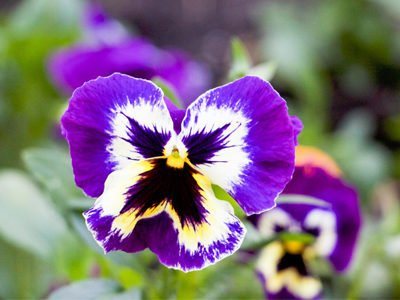

Protecting viola from pests
Flowers are often attacked by various pests, among which aphids, mealybugs and spider mites can be distinguished. Such troubles can be avoided by planting ready-made seedlings before the flowering of crops.
Of course, it is necessary to follow the planting recommendations of the variety you have chosen, but if the temperature is quite acceptable for planting in your region, you should not postpone planting.
If, nevertheless, the parasites attacked the beautiful pansies, do not despair, but take action immediately. For example, use a conventional pressure rinse with a hose. For two weeks, it is enough to carry out the procedure only 2-3 times.
In special cases and with severe damage, use special solutions that are safe for flowers, but destructive for all types of parasites.
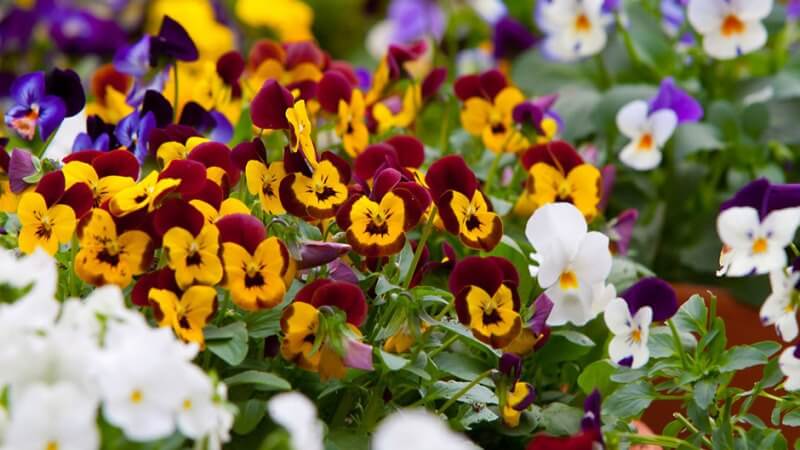

Pay attention to this material - Perennials blooming all summer.
Pansies medicinal properties
Violet tricolor is a unique medicinal plant that contains many useful substances: vitamin C, carotenoids, rutin, salicylic acid, trace elements, etc. Thanks to its chemicals, the plant helps to cope with coughs, bronchitis, gastric and intestinal diseases, urinary bladder, neuroses and insomnia.
There are contraindications in the use of viola. Do not use the plant for liver inflammation (hepatitis) and kidney disease (glomerulonephritis). Frequent use of tricolor violet decoction can irritate the stomach.
Influenza decoction: Pour one glass of hot water into a container. Add one tablespoon of dried, ground herb. Put the container on fire and boil for 15 minutes. Wait for the broth to cool and strain. Take one teaspoonful three times daily after meals.
Cough syrup: Add five tablespoons of dried, chopped herbs to a container. Pour in five cups of boiling water. Let the solution sit for twelve hours and then strain. Add five tablespoons of sugar and heat. Boil the composition until the syrup is thick. Add lemon juice five minutes before the end of cooking. Drink hot tea syrup - one tablespoon of syrup per glass of tea.
Popular types and varieties of viola
- Viola horned (Viola cornuta);
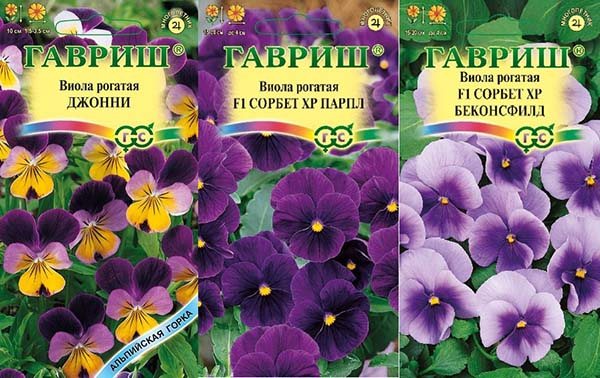

- Viola Wittrockiana;
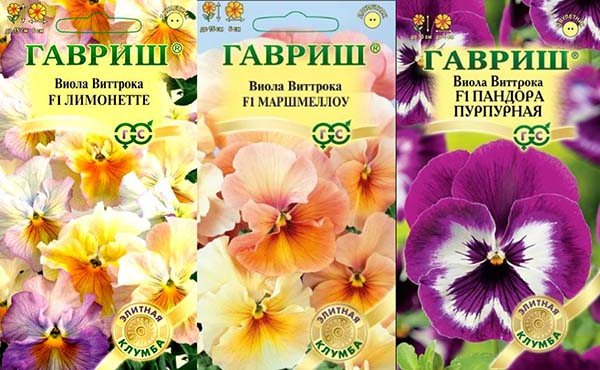

- Viola Williams (Viola williamsii);
